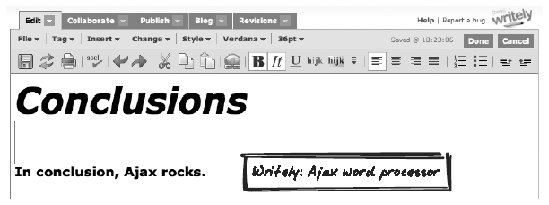Section 1.4. Webifying the Desktop: The Story of Office Applications
1.4. Webifying the Desktop: The Story of Office ApplicationsAttempts to webify office applications are almost as old as the Web itself. It's now part of computer folklore that Netscape's Marc Andreesen exclaimed, in the mid-1990s, that MS-Windows would be reduced to "a poorly debugged set of device drivers running Netscape Navigator," expecting to herald in a new era of desktop-style applications running inside the browser. The benefits of the Web over desktop apps are clear and abundante.g., an ability to access data from any web browser in the world, easy upgrading, no tampering of local machines, and better collaboration. However, there are serious problems too, and the most severe is interface. In the past, it's simply been impossible to produce a portable interface that's good enough to justify switching from the desktop. This is changing quickly though, thanks to Ajax.[*] A new generation of Ajax office applications (http://innerphaze.homelinux.com/blog/?p=28) are emerging as a serious substitute for MS-Word, Excel, and their desktop contemporaries.
One such offering is Writely, a Google acquisition billed as "The Web Word Processor" (Figure 1-3). Writely rightly avoids slavishly reproducing the desktop word-processing experience and instead aims for a feature set and interface that will work on the Web. The result is something that's as much a turbo-charged wiki as a webified word processor. The list that follows describes some of its features. Figure 1-3. Writely
The story of office applications illustrates there's enough new substance in Ajax to contemplate serious web versions of applications that have been stuck in the desktop forever. In addition to Writely, spreadsheets are being supported by the likes of NumSum (http://numsum.com) and presentation managers are being supported by the likes of S5 ((http://www.meyerweb.com/eric/tools/s5/). Beyond the office, there are Ajax versions of instant messaging clients (see Meebo at http://meebo.com), terminal emulators (see Anyterm at http://anyterm.org/), and even programming environments (see Why the Lucky Stiff's Try Ruby at http://tryruby.hobix.com/). Web applications will always be more limited than their desktop counterparts, but Ajax closes the gap to a point where many of them are suddenly "good enough." Being "good enough" will trump many users' desktop alternatives, thanks to the intrinsic benefits of working inside the browser. |